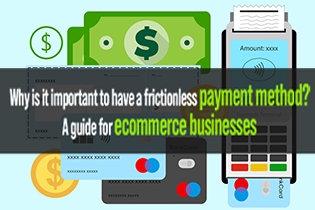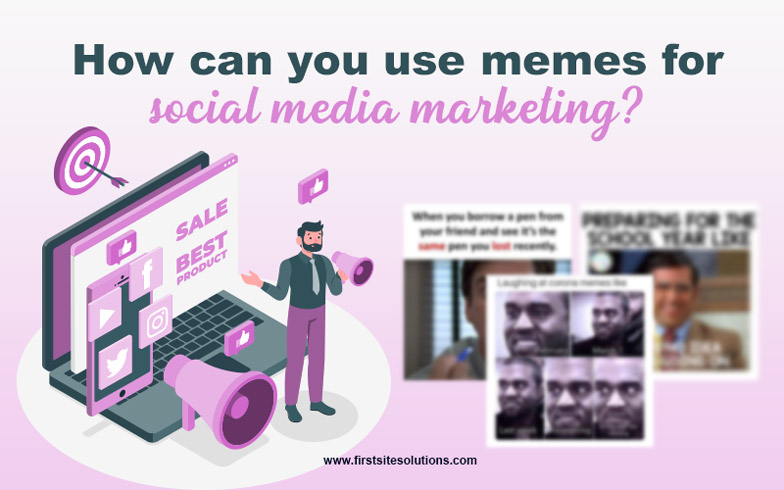
A hilarious meme series is a cure to all your marketing woes.
In a time when prospects would skip ads and never bother reading lengthy posts, a meme could convey your message in a classy way. You can pack cultural ideas and social norms into little nuggets of info, which have the potential for aggressive sharing.
Memes can grow, duplicate, and arguably define some corners of the digital arena. Marketers use memes to relate with their audience, build a community, and stick in their fans’ memory.
Anushk Mittal, the founder of meme platform Memeois, sheds light on his recent findings in this regard. He shares how more than 3 billion people use social media, and about 60% use it for funny content. College students exchange memes as kids traded Pokémon cards earlier.
The spark created by meme culture doesn’t seem to die down any sooner. In fact, it is hard to ignore that memes speak to people from all generations. Marketers in every industry must capitalize on this latest human inclination.
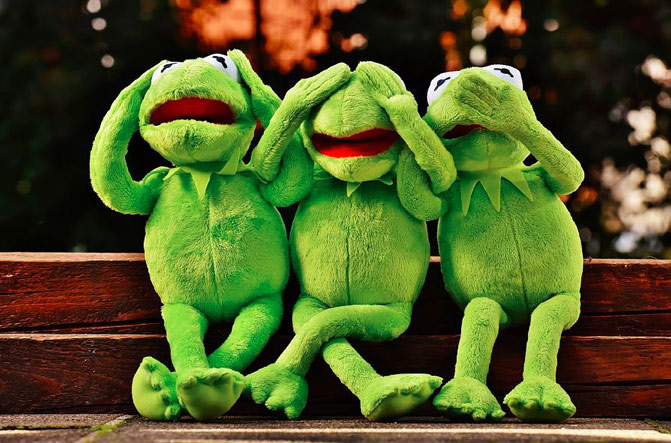
The Benefits of Meme Marketing
Memes allow marketers to connect with people in a much better way than traditional marketing. Following are some of the perks that tag along with this mode:
- Inexpensive content – Most meme content is the recreation of pre-existing photos funnily. This saves small businesses and digital marketers the time needed to produce original content. Plus, meme lovers value low-resolution, DIY content, so don’t worry if you have limited design skills.
- Supports community sense – Memes help to foster a sense of community among your followers. Your audience can relate to the emotions you are trying to evoke. If there is an absurd visual or a catchy tone, brand recall goes up a notch.
- Support/create brand relevance – Memes can make your brand more natural and human by relating it to a current trend or an event. The content you put out there serves to bring a community together. There is a common touchstone and makes your brand seem to be more relatable.
- It entices sharing – The meme content has a dynamic potential to get shared across various social platforms. When people send your meme to a friend for a laugh, they indirectly advocate for your brand.
A brand that is pioneering the use of memes in its content is Netflix. The online footprint set by this venture is flawless. Its meme content perfectly aligns with the entire marketing strategy. Netflix has learned how to highlight character nuances and fan-first moments to resonate with their shows' audience.

Such measures make it feel more like a best friend than a brand trying to sell products.
Going back to Mittal's observations, we can’t emphasize enough how memes are the real deal for brands in this era. He, along with his researchers, closely surveyed ten million meme interactions across a variety of topics. It turned out that the average Millennial looks at 20 – 30 memes every day.
How To Use Memes For Social Media Marketing?
After all the raging inclination observations towards memes, it is plausible to question how to blend them into your marketing campaign. A strategic talent executive gave the following statement to Digiday:
“Meme accounts get such a good return on investment compared to influencers, who no longer get the same results.”
With this perspective, companies must focus on meme marketing instead of operating on any other channels. Here is how decent meme marketing should work:
Find a meme that fits your brand
Like every component of digital marketing, memes should also revolve around the same brand voice. If you have a slight idea of how memes work, it could be the building block for your entire strategy. The next step is to develop a framework on how your humor will be like.
Some brands like geeky apparel sellers and video game companies have extensive meme vocabularies because their audience consumes memes every day. To find what memes are on the rise, look it up on Google Trends.
Misusing a meme will make you look tone-deaf. To steer clear, all you need to do is create a sketch of your ideal customers. You must be as specific as you can and go the extra mile by assigning a demographic profile to your potential customers.
Some questions to ask about your potential customers include:
- What content does the target audience consume?
- How can you entertain them?
- What music or TV shows they watch?
- What problems are they facing nowadays?
Detailed information enables you to identify the best way of talking to your customers. Eventually, helping you create the kind of memes and humor they would highly appreciate.
Barkbox, the monthly subscription box, is demonstrating brand voice alignment with memes. It is a box filled with treats and toys for the dogs.
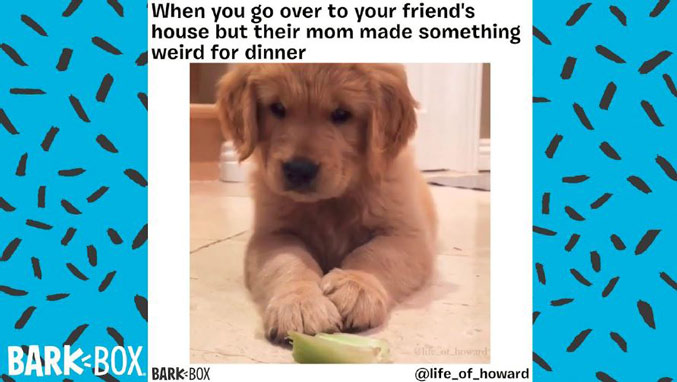
The company has managed to grow its audience by using relevant dog-related memes. It understands its audience quite well and produces a varied range of dog-related memes. Finding the fine line between humor and product placement is highly essential. And Barkbox has successfully done so!
Use relevant memes
Memes come and go like a roller coaster. Day one and millions share it. Yet on day two, people begin to think it is an exaggeration and criticize.
Each meme has a specific lifespan. Marketers should respect that. Use a meme on the decline, and your brand looks like it is behind the industry.
Seeming to be out-of-touch from the social bandwagon doesn’t bring good things your way. Having a dedicated meme-speaker is vital because several days of delay can be the difference between looking fresh or seem like you are out-of-touch.
However, there is another side of the picture you should learn too. Sometimes, embracing outdatedness in its dorky glory can communicate that you are willing to get silly and make people laugh.
Retro memes receive colossal appreciation as well. Rickrolls, Nyan Cat, and Kanye interrupting are the memes that are long past their peaks. This fact makes them a perfect nostalgia fodder.
If you plan to go retro with your memes, pay extra attention to the memes gaining popularity and the ones that are going down the spiral. Bear in mind, the way to your audiences’ hearts is the unique content, not merely meme-able photos.
McDonald's UK messed up quite nasty when they took a meme from 2015 and used the wrong format. It ended up embarrassing itself in front of 200K followers.
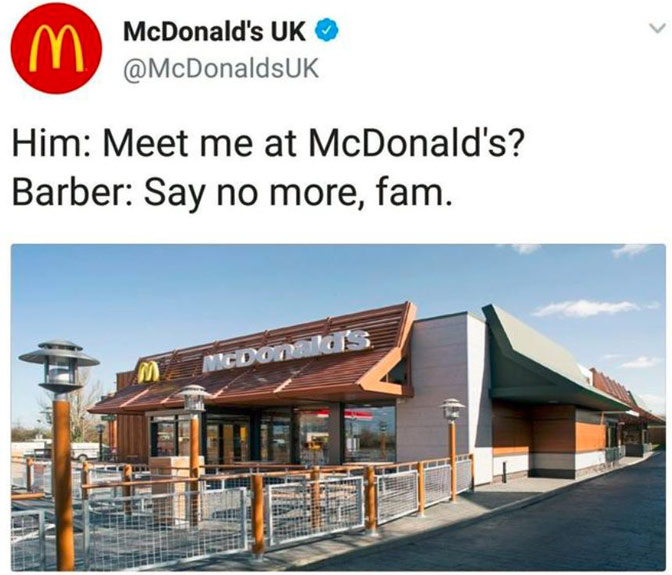
It doesn’t show any haircut in the image, leaving users fuzzed up on what this is about.
This teaches us how every meme you put out there must be relevant and go with the flow.
Develop your meme library
To expand your meme library, you can recreate the existing ones or craft your own meme content.
- Restructure existing memes
For starters, check out the meme template collections on GIPHY or imgflip. Look through the trending templates or viral photos and videos. Then, add a line or dialogue of your liking. Once you add a funny line, you spin the content for your brand prospects. It gives you a chance to convey your message and provide a delightful moment for your followers.
Barkbox, once more, sets a stellar example in this regard.

Stay on your toes to ensure your memes make a community. Inspire your viewers to turn the solitary activity of scrolling by social media posts into a social action of resharing it with friends/family.
Netflix, the all-time meme champ, uses a blend of mainstream meme formats and original Netflix content. Birdbox went viral after memes from the film were all over social media. They helped the movie get over 70 million views in 24 hours.
- Create original memes
Creating original content is a bit more challenging because you have to source material, decide the format, and overlay relatable statements. This will probably take more time, creativity, and energy to utilize for other forms of marketing. In the end, it is all worth it.
Another tactic to play in this domain is by asking your customers to share their photos with the product/service and share them after seeking permission.
Alternatively, you can have a photoshoot of people behind-the-scenes or using your product/service.
Following are a few pointers to keep in mind when designing custom memes for your brand:
Fonts – Twitter uses Montserrat or Helvetica Neue as the standard meme font. Creators also use Comic Sans, Arial, and others in varying contexts.
Style – Consider infusing rounded corners, embedded text, and emojis. Meme consumers are habitual of these visual elements and will recognize them within a jiffy.
Meme types – We have different ways to put meme content out there. You can use stock photos, videos, screenshots, or GIFs. Give a shot to all and see which one works out the best.
If not executed the right way, your whole meme structure can end up crashing and burning. In 2017, America’s famous fast-food chain, Wendy’s, made an error using a meme on Twitter. When a user on Twitter asked if they “got any memes,” they responded with the branded version of a famous meme “Pepe the Frog”. This brand overlooked the meaning of this meme, leading to an instant backlash.
Participate in meme challenges
Social media often comes up with meme challenges. They spread like wildfire, and it is the best chance for a brand to make the most out of this opportunity. An aptly designed meme game can help you gain all the eyeballs you crave for.
Castaway Clothing turned a popular Facebook #10YearChallenge to its benefit. The company compared its new logo to the new one.
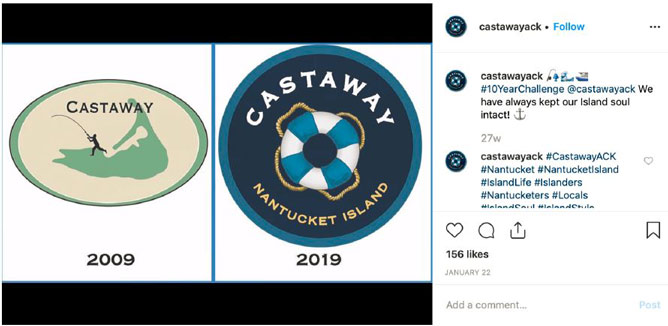
Look for opportunities like this and twist them creatively to make a mark upon users.
Repose user-generated memes
The core purpose of memes is to share and make people laugh. The creators aim to compose content that compels every viewer to pass it on. After ensuring they are staying within legal bounds, marketers can do so, i.e. no plagiarism or ridicule, etc.
When you are resharing the memes, you should try coming up with your tag or add to the joke. This brings a touch of creativity and appeals to the audience.
Or another tactic is to devise meme-making competitions. For this, you choose a meme-worthy photo and ask your followers to recreate those in a funny way. Try to work your brand into the image somehow.
But keep in mind, people will end up making jokes about your brand. You can repost the most cracking jokes on your profile during the campaign. After all, the motive is to stand in the limelight, and you achieved it.
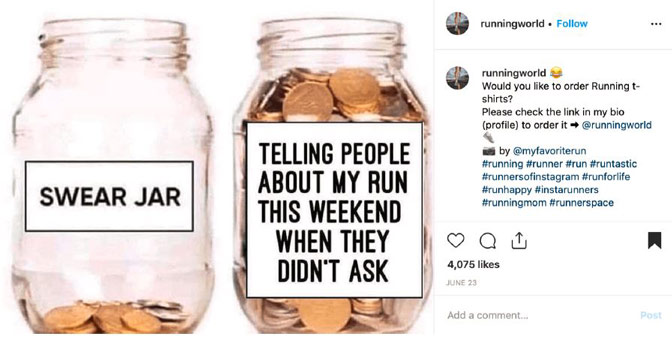
Running World reposted a swear jar meme for smaller accounts with attribution in the caption. This brought more exposure to the small publishers and got good content for its social media.
Don’t go overboard
Memes should be an additional component of your social media campaign.
You should work on other channels along with the memes to make a point. You cannot add a CTA with memes. It is always wise to build a link between memes and other content.
Final Thoughts
Memes are and will continue to grow in popularity. Brands must figure out how they can mix it up with the overall social media marketing. Humor is one thing that gets criticism over being lame or beyond the boundaries. You should be extra careful when designing memes as it should not offend a group, neither it should propose an unethical standing.
We suggest you get a digital marketing team onboard to help you make apt decisions. Memes have the potential to rock multiple platforms at the same time. Make sure you have a well-established meme-plan in place to get all the laughs!
Happy meme-ing!




